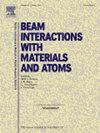Surface modification of Al-W laser-alloyed layer by high current pulsed electron beam irradiation
IF 1.4
3区 物理与天体物理
Q3 INSTRUMENTS & INSTRUMENTATION
Nuclear Instruments & Methods in Physics Research Section B-beam Interactions With Materials and Atoms
Pub Date : 2025-02-06
DOI:10.1016/j.nimb.2025.165629
引用次数: 0
Abstract
In this paper, high-current pulsed electron beam (HCPEB) technology was used to modify an Al-W alloying layer prepared by laser surface alloying (LSA). The microstructural changes were characterized by scanning electron microscope (SEM), X-ray diffractometer (XRD) and transmission electron microscope (TEM). The microhardness and friction properties were tested to explore the mechanism behind the performance enhancement. After HCPEB irradiation, the Al-W particles were dissolved and diffused to form a homogeneous re-melt layer on the topmost surface of Al-W laser-alloyed layer, approximately 20 μm thick. The phase compositions of the alloying layer consisted of α-Al, Al12W, Al5W, and Al4W phases. Additionally, HCPEB irradiation induced the formation of ultrafine crystals and a variety of crystal defect structures in the topmost Al-W laser-alloyed layer. The hardness of the Al-W laser-alloyed layer was significantly enhanced after HCPEB irradiation. Furthermore, the friction and wear properties of the alloying layer were significantly improved, which was mainly related to the formation of an abundant dislocation structure, Al-W particles and grain refinement.
求助全文
约1分钟内获得全文
求助全文
来源期刊
CiteScore
2.80
自引率
7.70%
发文量
231
审稿时长
1.9 months
期刊介绍:
Section B of Nuclear Instruments and Methods in Physics Research covers all aspects of the interaction of energetic beams with atoms, molecules and aggregate forms of matter. This includes ion beam analysis and ion beam modification of materials as well as basic data of importance for these studies. Topics of general interest include: atomic collisions in solids, particle channelling, all aspects of collision cascades, the modification of materials by energetic beams, ion implantation, irradiation - induced changes in materials, the physics and chemistry of beam interactions and the analysis of materials by all forms of energetic radiation. Modification by ion, laser and electron beams for the study of electronic materials, metals, ceramics, insulators, polymers and other important and new materials systems are included. Related studies, such as the application of ion beam analysis to biological, archaeological and geological samples as well as applications to solve problems in planetary science are also welcome. Energetic beams of interest include atomic and molecular ions, neutrons, positrons and muons, plasmas directed at surfaces, electron and photon beams, including laser treated surfaces and studies of solids by photon radiation from rotating anodes, synchrotrons, etc. In addition, the interaction between various forms of radiation and radiation-induced deposition processes are relevant.

 求助内容:
求助内容: 应助结果提醒方式:
应助结果提醒方式:


